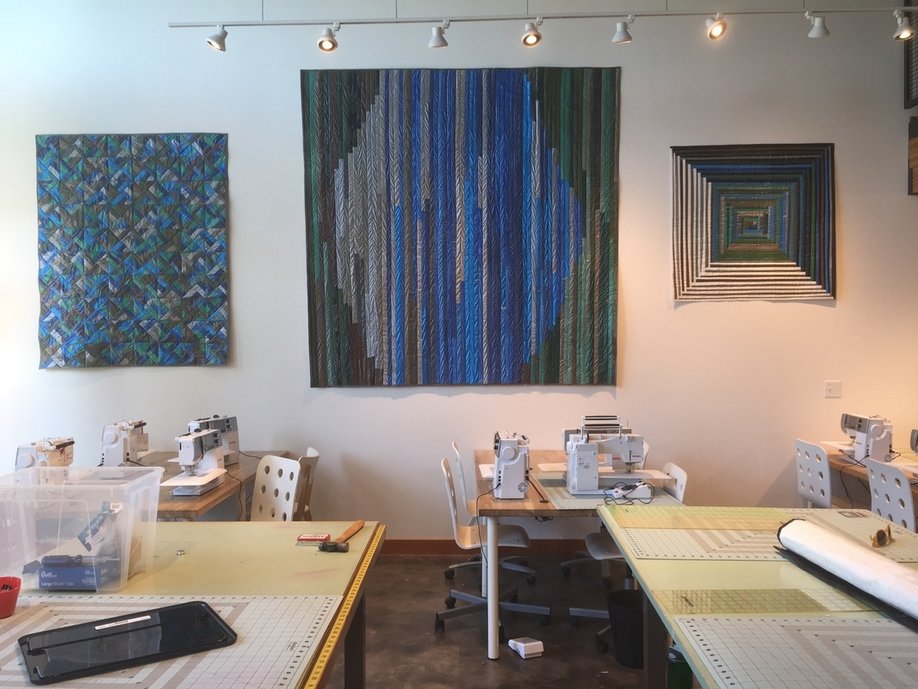A TOPOGRAPHY OF DOUBT, Tarp Quilts by Wynde Dyer
At Modern Domestic, August 2015

Artist Statement
“In the spring of 2012 I was displaced from my home of five years by a greedy landlord. My no-fault eviction came at a most inopportune time. I had just lost my corporate disability insurance, and shortly before that I liquidated my 401K and borrowed copious amounts of money from friends to finance a life-saving emergency surgery for my then-service dog. Without an income or the wellness to work, I had no choice but to give my housemates notice, to sell everything I owned in a fully-furnished 5-bedroom home, and move into a 1988 Volvo Wagon.
These quilts are about the hikes my dog and I took throughout the Pacific Northwest during our 9-month stint with homelessness. The city was no longer safe. Every house was a trigger. Every person was a threat. Prior to this time, I found no solace in nature. Nature was a place where wild animals, serial killers, or contaminated water would get you for sure. But somehow, when faced with the maddening realization that I could no longer afford to subsist in the quickly gentrifying city I had called home since 2001, nature became the lesser evil.
So we ventured out to the sea, into the Gorge, up the mountains, down into the valleys. We hiked all day, as many days a week as we could afford to fill up the tank. When we couldn’t buy enough gas to get to a trail-head, we’d swim and soak up the sun at our special place on the Sandy River. There were times I thought we might die from fatigue, heat stroke, hunger, dehydration, or sadness, but somehow we made it out alive. As I grew more attuned to my body, the psychological pain subsided, and, slowly, my terror was replaced with tranquility.
It is said that some individuals with trauma histories have difficulty connecting both to nature and to spirituality. It is also said that spirituality–specifically the spirituality one finds in communication with nature–is a powerful tool that can ultimately help traumatized individuals transcend their pain. In my case the pain of homelessness was not transcended, so much as it was mediated by the plodding on, against the obstacles, through nature, into a new awareness of my own nature, one of emerging resilience, across a topography of doubt.”
“In the spring of 2012 I was displaced from my home of five years by a greedy landlord. My no-fault eviction came at a most inopportune time. I had just lost my corporate disability insurance, and shortly before that I liquidated my 401K and borrowed copious amounts of money from friends to finance a life-saving emergency surgery for my then-service dog. Without an income or the wellness to work, I had no choice but to give my housemates notice, to sell everything I owned in a fully-furnished 5-bedroom home, and move into a 1988 Volvo Wagon.
These quilts are about the hikes my dog and I took throughout the Pacific Northwest during our 9-month stint with homelessness. The city was no longer safe. Every house was a trigger. Every person was a threat. Prior to this time, I found no solace in nature. Nature was a place where wild animals, serial killers, or contaminated water would get you for sure. But somehow, when faced with the maddening realization that I could no longer afford to subsist in the quickly gentrifying city I had called home since 2001, nature became the lesser evil.
So we ventured out to the sea, into the Gorge, up the mountains, down into the valleys. We hiked all day, as many days a week as we could afford to fill up the tank. When we couldn’t buy enough gas to get to a trail-head, we’d swim and soak up the sun at our special place on the Sandy River. There were times I thought we might die from fatigue, heat stroke, hunger, dehydration, or sadness, but somehow we made it out alive. As I grew more attuned to my body, the psychological pain subsided, and, slowly, my terror was replaced with tranquility.
It is said that some individuals with trauma histories have difficulty connecting both to nature and to spirituality. It is also said that spirituality–specifically the spirituality one finds in communication with nature–is a powerful tool that can ultimately help traumatized individuals transcend their pain. In my case the pain of homelessness was not transcended, so much as it was mediated by the plodding on, against the obstacles, through nature, into a new awareness of my own nature, one of emerging resilience, across a topography of doubt.”
